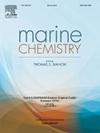Dissolved iron release by sediment and dust particles in Antarctic seawater greater than glacial flour and sea-ice particles
IF 2.5
3区 地球科学
Q2 CHEMISTRY, MULTIDISCIPLINARY
引用次数: 0
Abstract
Primary productivity by phytoplankton in the Southern Ocean can be limited by low iron concentrations. Iron limitation in the surface ocean around Antarctica may be alleviated by particle dissolution of dust from exposed rock, glacial flour, resuspended marine sediment, and sea ice. Ligands, which are ubiquitous in seawater, chelate some metals and keep them in solution. Ligands are thereby thought to increase metal solubility, including iron. Leaching studies of Antarctic particles from various sources are rare but important due to observed and predicted changes occurring around Antarctica, e.g., changes in sea ice and ice-free areas on the continent. Here, we quantified the solubility of iron in different particle types using vertical flow-through leaching experiments that simulated sinking through the water column and ran for 78 min of flow at 4 °C under trace metal-clean conditions. Both unaltered and ultraviolet-irradiated seawater leaching solution treatments were used to test the effect of organic ligands on iron dissolution, which was found to be non-significant. Sediment and dust released the most dissolved iron to seawater, followed by glacial flour, and then sea-ice particles (9.00 ± 9.92 × 10−2 and 3.18 ± 3.79 × 10−2, 1.97 ± 1.79 × 10−4, 1.37 ± 0.90 × 10−9 g DFe/100 g material, respectively). We discuss these laboratory results in relation to particle availability and how this may affect the supply of dissolved iron to Antarctic surface waters.

南极海水中沉积物和尘埃颗粒释放的溶解铁大于冰川粉和海冰颗粒
南大洋浮游植物的初级生产力可能受到低铁浓度的限制。由于暴露的岩石、冰川粉、再悬浮的海洋沉积物和海冰中粉尘的颗粒溶解,南极洲周围海洋表面的铁限制可能会得到缓解。配体在海水中无处不在,它能螯合一些金属并使其保持在溶液中。因此,配体被认为可以增加金属的溶解度,包括铁。对来自各种来源的南极颗粒进行浸出研究是罕见的,但由于南极周围发生的观测和预测变化,例如南极大陆海冰和无冰区的变化,研究很重要。在这里,我们通过垂直流动浸出实验来量化铁在不同颗粒类型中的溶解度,模拟通过水柱下沉,在4°C的微量金属清洁条件下运行78分钟的流动。在未改变和紫外线照射的海水浸出液处理下,测试了有机配体对铁溶解的影响,发现有机配体对铁溶解的影响不显著。沉积物和粉尘向海水释放的溶解铁最多,其次是冰川粉,其次是海冰颗粒(分别为9.00±9.92 × 10−2和3.18±3.79 × 10−2,1.97±1.79 × 10−4,1.37±0.90 × 10−9 g DFe/100 g材料)。我们将讨论这些实验室结果与颗粒有效性的关系,以及这可能如何影响南极地表水中溶解铁的供应。
本文章由计算机程序翻译,如有差异,请以英文原文为准。
求助全文
约1分钟内获得全文
求助全文
来源期刊

Marine Chemistry
化学-海洋学
CiteScore
6.00
自引率
3.30%
发文量
70
审稿时长
4.5 months
期刊介绍:
Marine Chemistry is an international medium for the publication of original studies and occasional reviews in the field of chemistry in the marine environment, with emphasis on the dynamic approach. The journal endeavours to cover all aspects, from chemical processes to theoretical and experimental work, and, by providing a central channel of communication, to speed the flow of information in this relatively new and rapidly expanding discipline.
 求助内容:
求助内容: 应助结果提醒方式:
应助结果提醒方式:


